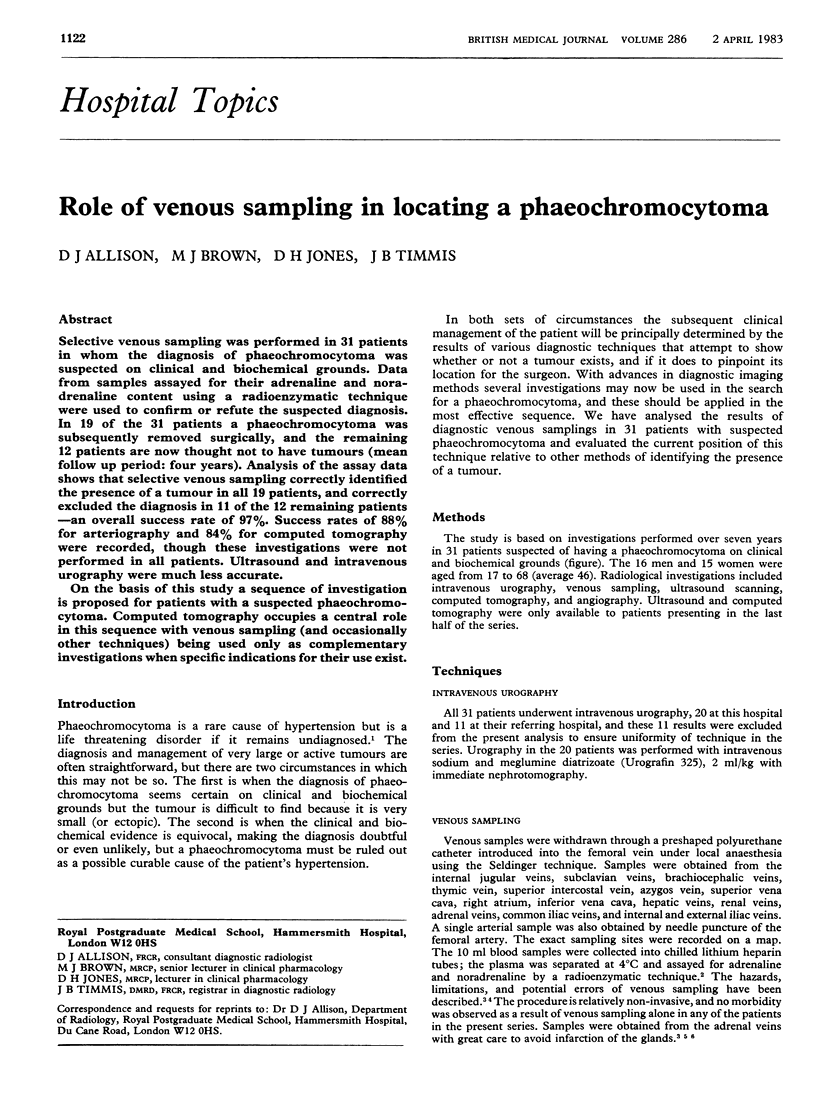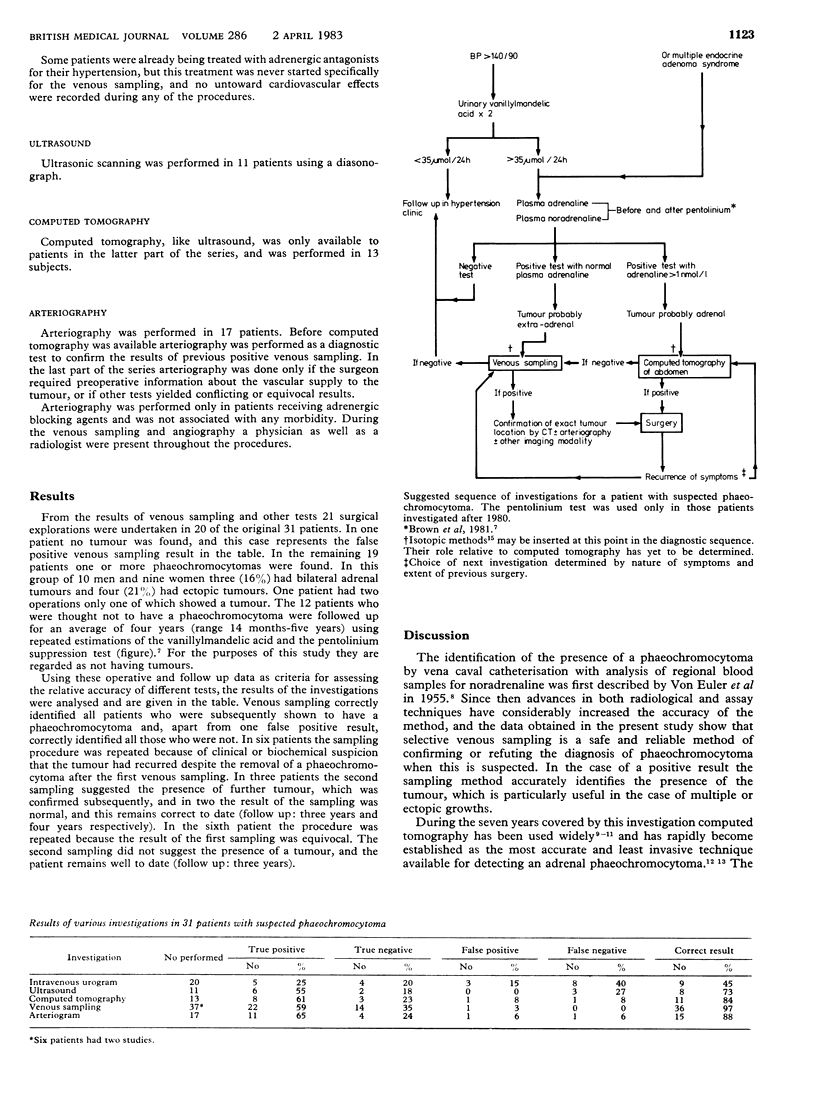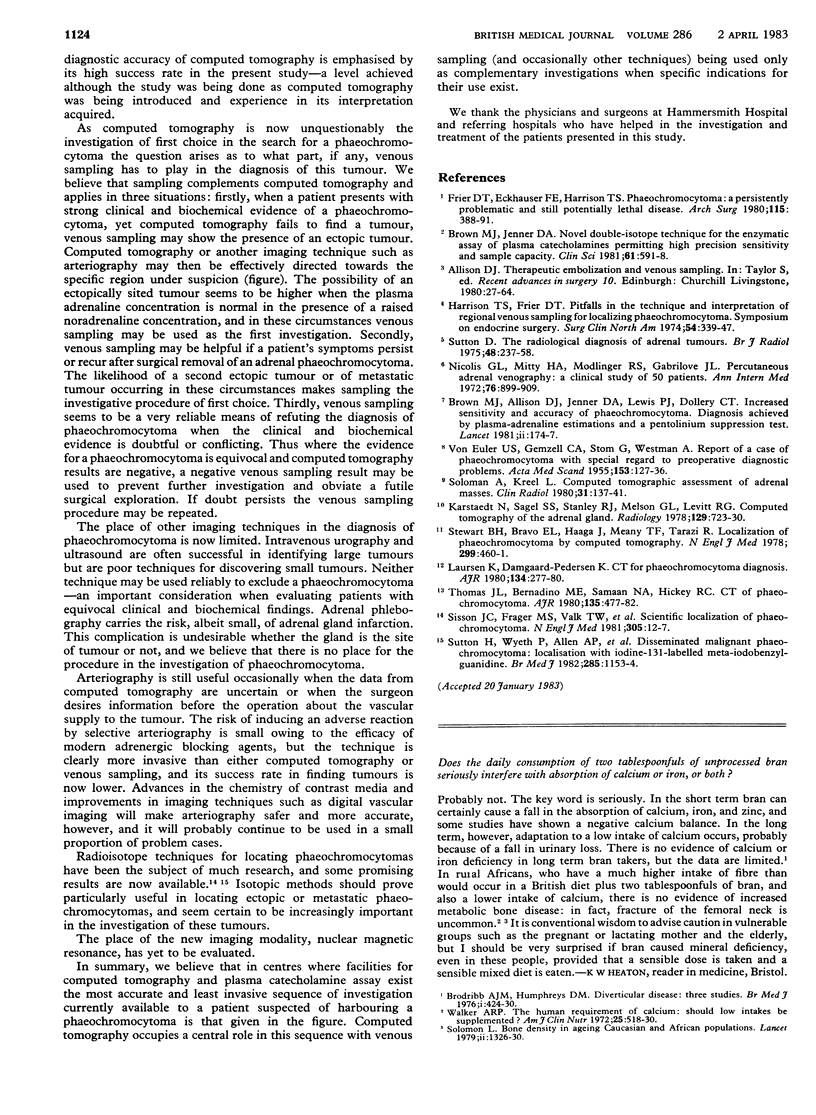Abstract
Selective venous sampling was performed in 31 patients in whom the diagnosis of phaeochromocytoma was suspected on clinical and biochemical grounds. Data from samples assayed for their adrenaline and noradrenaline content using a radioenzymatic technique were used to confirm or refute the suspected diagnosis. In 19 of the 31 patients a phaeochromocytoma was subsequently removed surgically, and the remaining 12 patients are now thought not to have tumours (mean follow up period: four years). Analysis of the assay data shows that selective venous sampling correctly identified the presence of a tumour in all 19 patients, and correctly excluded the diagnosis in 11 of the 12 remaining patients--an overall success rate of 97%. Success rates of 88% for arteriography and 84% for computed tomography were recorded, though these investigations were not performed in all patients. Ultrasound and intravenous urography were much less accurate. On the basis of this study a sequence of investigation is proposed for patients with a suspected phaeochromocytoma. Computed tomography occupies a central role in this sequence with venous sampling (and occasionally other techniques) being used only as complementary investigations when specific indications for their use exist.
Full text
PDF


Selected References
These references are in PubMed. This may not be the complete list of references from this article.
- Brodribb A. J., Humphreys D. M. Diverticular disease: three studies. Part I--Relation to other disorders and fibre intake. Br Med J. 1976 Feb 21;1(6007):424–425. doi: 10.1136/bmj.1.6007.424. [DOI] [PMC free article] [PubMed] [Google Scholar]
- Brown M. J., Allison D. J., Jenner D. A., Lewis P. J., Dollery C. T. Increased sensitivity and accuracy of phaeochromocytoma diagnosis achieved by use of plasma-adrenaline estimations and a pentolinium-suppression test. Lancet. 1981 Jan 24;1(8213):174–177. doi: 10.1016/s0140-6736(81)90058-1. [DOI] [PubMed] [Google Scholar]
- Brown M. J., Jenner D. A. Novel double-isotope technique for enzymatic assay of catecholamines, permitting high precision, sensitivity and plasma sample capacity. Clin Sci (Lond) 1981 Nov;61(5):591–598. doi: 10.1042/cs0610591. [DOI] [PubMed] [Google Scholar]
- Freier D. T., Eckhauser F. E., Harrison T. S. Pheochromocytoma. A persistently problematic and still potentially lethal disease. Arch Surg. 1980 Apr;115(4):388–391. doi: 10.1001/archsurg.1980.01380040022003. [DOI] [PubMed] [Google Scholar]
- Harrison T. S., Freier D. T. Pitfalls in the technique and interpretation of regional venous sampling for localizing pheochromocytoma. Surg Clin North Am. 1974 Apr;54(2):339–347. doi: 10.1016/s0039-6109(16)40283-5. [DOI] [PubMed] [Google Scholar]
- Karstaedt N., Sagel S. S., Stanley R. J., Melson G. L., Levitt R. G. Computed tomography of the adrenal gland. Radiology. 1978 Dec;129(3):723–730. doi: 10.1148/129.3.723. [DOI] [PubMed] [Google Scholar]
- Laursen K., Damgaard-Pedersen K. CT for pheochromocytoma diagnosis. AJR Am J Roentgenol. 1980 Feb;134(2):277–280. doi: 10.2214/ajr.134.2.277. [DOI] [PubMed] [Google Scholar]
- Nicolis G. L., Mitty H. A., Modlinger R. S., Gabrilove J. L. Percutaneous adrenal venography. A clinical study of 50 patients. Ann Intern Med. 1972 Jun;76(6):899–910. doi: 10.7326/0003-4819-76-6-899. [DOI] [PubMed] [Google Scholar]
- Solomon A., Kreel L. Computed tomographic assessment of adrenal masses. Clin Radiol. 1980 Mar;31(2):137–141. doi: 10.1016/s0009-9260(80)80137-1. [DOI] [PubMed] [Google Scholar]
- Solomon L. Bone density in ageing Caucasian and African populations. Lancet. 1979 Dec 22;2(8156-8157):1326–1330. doi: 10.1016/s0140-6736(79)92813-7. [DOI] [PubMed] [Google Scholar]
- Stewart B. H., Bravo E. L., Haaga J., Meaney T. F., Tarazi R. Localization of pheochromocytoma by computed tomography. N Engl J Med. 1978 Aug 31;299(9):460–461. doi: 10.1056/NEJM197808312990907. [DOI] [PubMed] [Google Scholar]
- Sutton D. The radiological diagnosis of adrenal tumours. Br J Radiol. 1975 Apr;48(568):237–258. doi: 10.1259/0007-1285-48-568-237. [DOI] [PubMed] [Google Scholar]
- Sutton H., Wyeth P., Allen A. P., Thurtle O. A., Hames T. K., Cawley M. I., Ackery D. Disseminated malignant phaeochromocytoma: localisation with iodine-131-labelled meta-iodobenzylguanidine. Br Med J (Clin Res Ed) 1982 Oct 23;285(6349):1153–1154. doi: 10.1136/bmj.285.6349.1153. [DOI] [PMC free article] [PubMed] [Google Scholar]
- Thomas J. L., Bernardino M. E., Samaan N. A., Hickey R. C. CT of pheochromocytoma. AJR Am J Roentgenol. 1980 Sep;135(3):477–482. doi: 10.2214/ajr.135.3.477. [DOI] [PubMed] [Google Scholar]
- VON EULER U. S., GEMZELL C. A., STROM G., WESTMAN A. Report of a case of pheochromocytoma, with special regard to preoperative diagnostic problems. Acta Med Scand. 1955 Dec 20;153(2):127–136. doi: 10.1111/j.0954-6820.1955.tb18211.x. [DOI] [PubMed] [Google Scholar]
- Walker A. R. The human requirement of calcium: should low intakes be supplemented? Am J Clin Nutr. 1972 May;25(5):518–530. doi: 10.1093/ajcn/25.5.518. [DOI] [PubMed] [Google Scholar]


